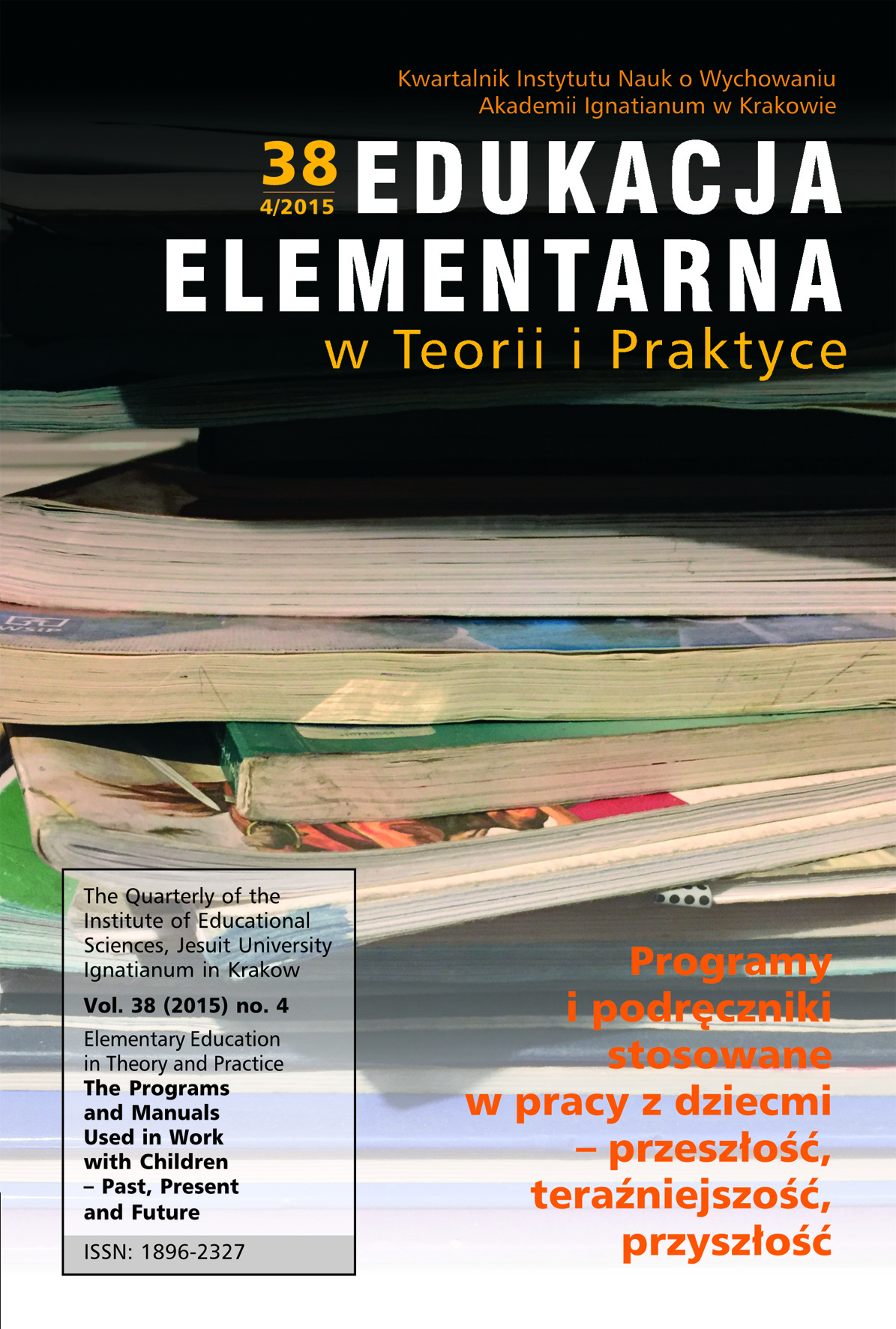Muzyka instrumentalna i jej wpływ na jakość wytworów plastycznych dzieci 7-letnich – raport z badań
Abstrakt
W wychowaniu współczesnego człowieka szczególnie doniosłą rolę przypisuje się sztuce. Integralne, całościowe rozumienie sztuki i jej wychowawczego oddziaływania pozwala na stwierdzenie, że sztuka ma dziecku wiele do zaoferowania. Uczestniczy w kształtowaniu jego intelektu, wrażliwości, kreatywności, wyobraźni i postawy twórczej, które stanowią niewątpliwie największe skarby każdej jednostki i powinny być pielęgnowane i rozwijane od pierwszych lat jej życia. Różnorodne podejścia do twórczości dzieci oraz próby stymulacji ich rozwoju plastycznego są przedmiotem badań wielu polskich i zagranicznych pedagogów (S. Popek, I. Wojnar, U. Szuścik, S. Szuman, V. Lowenfeld, P. Wallon i inni), dlatego zainteresowanie tym tematem potwierdza ważność problemu zawartego w niniejszym opracowaniu. Jego rozwiązanie sprowadzało się do ustalenia, czy intensyfikacja procesu dydaktyczno-wychowawczego dzieci 7-letnich poprzez inspirowanie wyobraźni bodźcami w postaci muzyki instrumentalnej uczyni proces działania twórczego aktywniejszym, bardziej interesującym dla ucznia, a także skuteczniejszym z uwagi na ostateczny jego efekt. Zasadniczą metodą badań jaką zastosowano w prezentowanej pracy był naturalny eksperyment pedagogiczny. W przypadku tego eksperymentu oparto się na kanonie jedynej różnicy. Zastosowano również technikę obserwacji skategoryzowanej oraz technikę wywiadu ex post. Na podstawie uzyskanych wyników badań można przyjąć, iż stymulacja aktywności plastycznej bodźcami słuchowymi w postaci programowej muzyki instrumentalnej wzbogaca jakość wytworów plastycznych dzieci 7-letnich. Zajęcia plastyczne o charakterze integracyjnym są korzystniejsze dla dzieci ze względu na fakt, iż w większym stopniu rozwijają inwencję twórczą autora pracy plastycznej oraz kształcą jego wrażliwość artystyczną i procesy poznawcze (spostrzeganie, myślenie, wyobraźnię). Pobudzają zatem różne sfery aktywności dziecka, co sprzyja harmonijnemu i wszechstronnemu rozwijaniu osobowości.Bibliografia
Bonna-Medyńska B., Muzyka w zintegrowanym systemie wychowania przedszkolnego, [w:] Muzyka środkiem wychowania młodych, (red.) J. Lach, Z. Nawrocka, M. Popielińska, Wyd. Akademii Bydgoskiej im. Kazimierza Wielkiego, Bydgoszcz 2001.
Burowska Z., Wprowadzenie w kulturę muzyczną, WSiP, Warszawa 1991.
Chodkowski A. (red.), Encyklopedia muzyki, PWN, Warszawa 1995.
Hanisz J., Wesoła szkoła i przyjaciele. Program edukacji wczesnoszkolnej w klasach 1–3 szkoły podstawowej, WSiP, Warszawa 2009.
Janicka-Panek T., Małkowska-Zegadło H., Bieleń B., Elementarz XXI wieku. Program nauczania dla I etapu – edukacji wczesnoszkolnej, Wyd. Nowa Era, Warszawa 2014.
Janicka-Panek T., Małkowska-Zegadło H., Bieleń B., Szkoła na miarę. Program nauczania dla I etapu – edukacji wczesnoszkolnej, Wyd. Nowa Era, Warszawa 2009.
Kisiel M., Muzyka w zintegrowanej edukacji wczesnoszkolnej. Studium metodyczno-badawcze, Wyd. Uniwersytetu Śląskiego, Katowice 2005.
Lipska E., Muzyka 2, WSiP, Warszawa 1989.
Maszke A.W., Tok przygotowywania badań, [w:] Podstawy metodologii badań w pedagogice, (red.) S. Palka, GWP, Gdańsk 2010.
Murzyn A., Wokół Kena Robinsona kreatywnego myślenia o edukacji, Impuls, Kraków 2013.
Natorff A., Popularyzacja osiągnięć plastycznych dzieci i młodzieży, WSiP, Warszawa 1988.
Popek S.L., Psychologia twórczości plastycznej, Impuls, Kraków 2010.
Rubacha K., Metodologia badań nad edukacją, WAiP, Warszawa 2008.
Sacher W.A., Pedagogika muzyki. Teoretyczne podstawy powszechnego kształcenia muzycznego, Impuls, Kraków 2012.
Sacher W.A., Słuchanie muzyki i aktywność artystyczna dzieci, Impuls, Kraków 1999.
Szuścik U., Kształtowanie percepcji wzrokowej jako stymulator działań plastycznych dziecka, Wyd. Uniwersytetu Śląskiego, Cieszyn 1999.
Szuścik U., Muzyka stymulacją aktywności plastycznej. Z doświadczeń kształcenia plastycznego dzieci i studentów, [w:] Z teorii i praktyki wychowania muzycznego, (red.) H. Danel-Bobrzyk, Wyd. Uniwersytetu Śląskiego, Katowice 1997.
Szuścik U., Program autorski z zakresu kształcenia plastycznego dziecka w młodszym wieku szkolnym, Muza Szkolna, Warszawa 2000.
Żylińska M., Neurodydaktyka. Nauczanie i uczenie się przyjazne mózgowi, Wyd. Nauk. UMK, Toruń 2013.
Copyright (c) 2016 Edukacja Elementarna w Teorii i Praktyce

Utwór dostępny jest na licencji Creative Commons Uznanie autorstwa – Bez utworów zależnych 4.0 Międzynarodowe.
1. Autor zgłaszając swój artykuł oświadcza, że jest Autorem artykułu (zwanego dalej Utworem) i:
- przysługują mu wyłączne i nieograniczone prawa autorskie do Utworu,
- jest uprawniony/a do rozporządzania prawami autorskimi do Utworu.
Oświadcza, że nie narusza praw autorskich osób trzecich i praw prawnych.
Oświadcza, że nie występuje żaden konflikt interesów.
2. Udziela Uniwersytetowi Ignatianum w Krakowie nieodpłatnej, niewyłącznej, nieograniczonej terytorialnie licencji do korzystania z Utworu na następujących polach eksploatacji:
- utrwalania utworu w formie papierowej, a także na nośniku cyfrowym lub magnetycznym;
- zwielokrotnienia utworu dowolną techniką, bez ograniczenia ilości wydań i liczby egzemplarzy;
- rozpowszechniania utworu i jego zwielokrotnionych egzemplarzy na jakimkolwiek nośniku, w tym wprowadzenia do obrotu, sprzedaży, użyczenia, najmu;
- wprowadzenia utworu do pamięci komputera;
- rozpowszechniania utworu w sieciach informatycznych, w tym w sieci Internet;
- publicznego wykonania, wystawienia, wyświetlenia, odtworzenia oraz nadawania i reemitowania, a także publicznego udostępniania utworu w taki sposób, aby każdy mógł mieć do niego dostęp w miejscu i czasie przez siebie wybranym;
- w zakresie praw zależnych do Utworu, obejmujących w szczególności prawo do dokonania koniecznych zmian w Utworze, wynikających z opracowania redakcyjnego i metodycznego, a także do dokonania tłumaczenia Utworu na języki obce.
Udzielenie licencji następuje z chwilą przekazania Utworu na rzecz Uniwersytetowi Ignatianum w Krakowie. Uniwersytet Ignatianum w Krakowie jest uprawniony do udzielania dalszych sublicencji do Utworu, w zakresie udzielonego prawa. Licencja jest ograniczona czasowo i zostaje udzielona na okres 15 lat, licząc od daty jej udzielenia.
Wyraża się zgodę i zachęca autorów do publikacji ich tekstu w Internecie (np. w repozytorium instytucji lub na jej stronie internetowej) przed lub podczas procesu składania tekstu jako, że może to prowadzić do korzystnych wymian oraz wcześniejszego i większego cytowania opublikowanego tekstu (Patrz The Effect of Open Access). Zalecamy wykorzystanie dowolnego portalu stowarzyszeń badawczych z niżej wymienionych:




